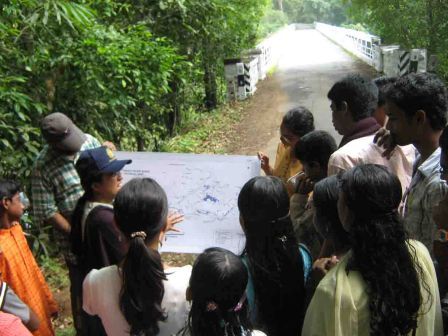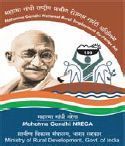India
River schools can make the future look bright - Parineeta Dandekar
Posted on 04 Mar, 2011 01:25 PM Above - Children studying a map of the Chalakudy Basin. Photo - RRC.
Above - Children studying a map of the Chalakudy Basin. Photo - RRC.
Seeds of sustainability and sensitivity when sown at a young age, blossom into responsible individuals. And you need to be in touch with the land to sow those seeds. The Central and State Boards of Education in India have made Environmental Science a compulsory subject for schools and junior colleges (for all subjects). But Environmental Sciences is not to be studied in the classroom. In order to understand the erosion and deposition processes of a river, students need to visit a river bend in their city and in order to instil a lifelong aversion to plastic bags, a landfill and dumping grounds need to be seen.
"Civil society groups to do NREGA audit again"
Posted on 04 Mar, 2011 11:56 AM

Main highlights in this update:
Social impact assessment of resettlement & rehabilitation policies and packages in India - Report of a research project by Centre for Social Development
Posted on 02 Mar, 2011 08:37 AMThe National Resettlement and Rehabilitation (R&R) policy, issued in 2007, recognizes the need to carry out Social Impact Assessment (SIA) as part of the resettlement planning and implementation processes. While an assessment of social impacts prior to the commencement of a new project or expansion of an existing is now obligatory under this new policy, the appropriate guidelines for the purpose do not yet exist. This handbook on conducting social impact assessments aims to fill this gap.
Co-processing of distillery spent wash concentrate in cement industry – Inviting comments on the draft guidelines by the Central Pollution Control Board (2010)
Posted on 01 Mar, 2011 09:48 PMIn order to utilize the hazardous wastes generated in the cement industry the Central Pollution Control Board has come up with the draft guidelines (in February 2010) dealing with the co-processing of distillery spent wash concentrate in the cement industry.
Robert Chambers speaks about health, nutrition, sanitation and CLTS at the International Development Select Committee on the future of DFID's programme in India
Posted on 01 Mar, 2011 03:18 PMHe spoke about health, nutrition and sanitation in India and specifically referring to CLTS.
Download the below attachment for written evidence given by Robert Chambers
Alkaline soils: Characteristics and treatment - Ramnaresh
Posted on 28 Feb, 2011 12:33 PMक्षारीय मृदाओं के लक्षण तथा सुधार
Steps to create awareness about rainwater harvesting and encouragement to states for implementation of rainwater harvesting projects - PIB release
Posted on 25 Feb, 2011 10:41 AMGiving this information in written reply to a question in the Lok Sabha on the average annual rainfall and rainwater harvesting, Shri Salman Khurshid, Minister of Water Resources, said that rain water is harvested through surface storages and recharge of ground water.The total storage capacity created through major and medium projects is around 225 BCM. The data on quantum of rainwater harvested through groundwater recharging is 433 BCM. Ministry of Water Resources does not maintain the data on quantum of water harvested due to manmade structures separately.It is estimated that the water utilized in 2010 is about 681 BCM.
A map of World Water Day 2011 events across India
Posted on 24 Feb, 2011 04:09 PMWelcome to the World Water Day Events 2011.